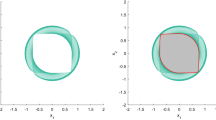Abstract
In this paper, an exact dual is derived for Semidefinite Programming (SDP), for which strong duality properties hold without any regularity assumptions. Its main features are: (i) The new dual is an explicit semidefinite program with polynomially many variables and polynomial size coefficient bitlengths. (ii) If the primal is feasible, then it is bounded if and only if the dual is feasible. (iii) When the primal is feasible and bounded, then its optimum value equals that of the dual, or in other words, there is no duality gap. Further, the dual attains this common optimum value. (iv) It yields a precise theorem of the alternative for semidefinite inequality systems, i.e. a characterization of theinfeasibility of a semidefinite inequality in terms of thefeasibility of another polynomial size semidefinite inequality.
The standard duality for linear programming satisfies all of the above features, but no such explicit gap-free dual program of polynomial size was previously known for SDP, without Slater-like conditions being assumed. The dual is then applied to derive certain complexity results for SDP. The decision problem of Semidefinite Feasibility (SDFP), which asks to determine if a given semidefinite inequality system is feasible, is the central problem of interest, he complexity of SDFP is unknown, but we show the following: (i) In the Turing machine model, the membership or nonmembership of SDFP in NP and Co-NP is simultaneous; hence SDFP is not NP-Complete unless NP=Co-NP. (ii) In the real number model of Blum, Shub and Smale, SDFP is in NP∩CoNP.
Similar content being viewed by others
References
F. Alizadeh, Combinatorial optimization with interior point methods and semi-definite matrices, Ph.D. Thesis, Computer Science Department, University of Minnesota, Minneapolis, MN, 1991.
F. Alizadeh, Interior point methods in semidefinite programming with applications to combinatorial optimization,SIAM J. Optimization 5 (1) 1995.
J. Borwein and H. Wolkowicz, Regularizing the abstract convex program,J. Math. Anal. Appl. 83 (1981).
S. Boyd, L. El Ghaoui, E. Feron and V. Balakrishnan,Linear Matrix Inequalities in System and Control Theory, Studies in Applied Mathematics, Vol. 15 (SIAM, Philadelphia, PA, 1994).
L. Blum, M. Shub and S. Smale, On a theory of computation and complexity over the real numbers: NP-completeness, recursive functions and universal machines,Bull. Amer. Math. Soc. (N.S.) 21 (1) (1989) 1–46.
A. Brøndsted,An Introduction to Convex Polytopes (Springer, New York, 1983).
V. Chvátal,Linear Programming (Freeman, New York, 1983).
R. Freund, Complexity of an algorithm for finding an approximate solution of a semi-definite program, with no regularity condition, Working Paper, OR 302-94, 1994.
M.R. Garey and D.S. Johnson,Computers and Intractability: A Guide to the Theory of NP-completeness (Freeman, New York, 1979).
M.X. Goemans and D.P. Williamson, Improved approximation algorithms for maximum cut and satisfiability problems using semidefinite programming,J. ACM 42 (1995) 1115–1145.
M. Grötschel, L. Lovász and A. Schrijver, Polynomial algorithms for perfect graphs, in: C. Berge and V. Chvátal, eds.,Annals of Discrete Mathematics, Vol. 21 (North-Holland, Amsterdam, 1984).
M. Grötschel, L. Lovász and A. Schrijver,Geometric Algorithms and Combinatorial Optimization (Springer, Berlin, 1988).
R.B. Holmes,Geometric Functional Analysis and its Applications (Springer, New York, 1975).
R. Horn and C.R. Johnson,Matrix Analysis (Cambridge University Press, Cambridge, MA, 1985).
F. Jarre, An interior point method for minimizing the maximum eigenvalue of a linear combination of matrices, Report SOL 91-8, Dept. of OR, Stanford University, Stanford, CA, 1991.
D.S. Johnson, C.H. Papadimitriou and M. Yannakakis, How easy is local search?,J. Computer and System Science 37 (1988) 79–100.
L. Porkolab and L. Khachiyan, On the complexity of semidefinite programs, RUTCOR Research Report, RRR 40-95, Rutgers University, New Brunswick, NJ-08903; to appear inJ. Global Optimization (1997).
Y. Nesterov and A. Nemirovskii,Interior Point Polynomial Methods for Convex Programming: Theory and Applications (SIAM, Philadelphia, PA, 1994).
M.L. Overton, Large-scale optimization of eigenvalues,SIAM J. Optimization 2 (1992) 88–120.
G. Pataki, Semidefinite and cone programming: Geometry and simplex-type methods, Ph.D. Thesis, GSIA, Carnegie Mellon University, Pittsburgh, under preparation.
M.V. Ramana, An algorithmic analysis of multiquadratic and semidefinite programming problems, Ph.D. Thesis, The Johns Hopkins University, Baltimore, MD, 1993.
M.V. Ramana and R.M. Freund, A gap-free corrected primal for semidefinite programming, in preparation, 1996.
M.V. Ramana and A.J. Goldman, Some geometric results in semidefinite programming,J. Global Optimization 7 (1995) 33–50.
M.V. Ramana and P.M. Pardalos, Semidefinite Programming, T. Terlaky, ed.,Interior Point Methods in Mathematical Programming (Kluwer Academic Publishers, 1996) 369–398.
M.V. Ramana, E.R. Scheinerman and D. Ullman, Fractional isomorphism of graphs,Discrete Mathematics 132 (1994) 247–265.
M.V. Ramana, L. Tunçel and H. Wolkowicz, Strong duality in semidefinite programming,SIAM J. Optimization, to appear (1997).
T.R. Rockafellar,Convex Analysis (Princeton University Press, Princeton, NJ, 1970).
L. Vandenberghe and S. Boyd, Positive-definite programming, in: J.R. Birge and K.G. Murty, eds.,Mathematical Programming: State of the Art 1994 (University of Michigan, 1994).
L. Vandenberghe and S. Boyd, Semidefinite programming,SIAM Review 38 (1996) 49–95.
H. Wolkowicz, Some applications of optimization in matrix theory,Linear Algebra and its Applications 40 (1981) 101–118.
Author information
Authors and Affiliations
Rights and permissions
About this article
Cite this article
Ramana, M.V. An exact duality theory for semidefinite programming and its complexity implications. Mathematical Programming 77, 129–162 (1997). https://doi.org/10.1007/BF02614433
Received:
Issue Date:
DOI: https://doi.org/10.1007/BF02614433




